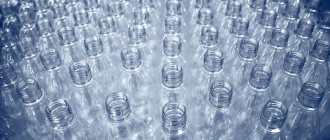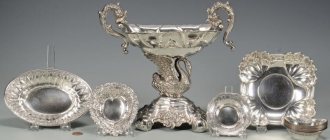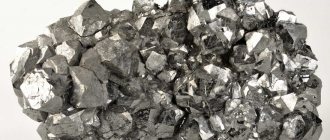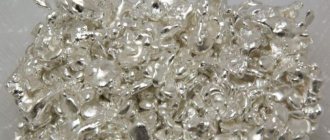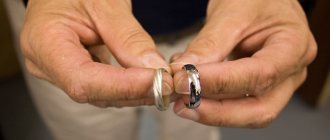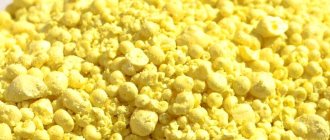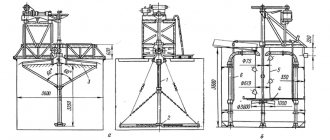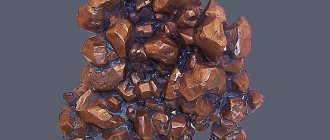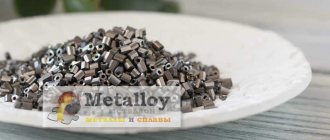Silver in Rus'
In ancient Rus', the measure of the value of various items was bars of silver. In cases where an item of trade was worth less than the entire bar, a part corresponding to the indicated value of the item was cut off from it. These parts were called “rubles.” It was from them that the name of the currency adopted in Russia, the ruble, came.
As early as 2500 BC, Egyptian warriors used silver to treat battle wounds. They applied thin plates of silver to them, and the wounds healed quickly. In the Russian Orthodox Church, holy water for parishioners was kept only in silver vessels. Since the middle of the last century, such industries as photography, electrical engineering, and radio electronics have appeared, which led to a sharp increase in demand for silver and its withdrawal from monetary circulation.
The high electrical conductivity, good ductility, low melting point, and low chemical activity of silver also interested radio engineers.
Chlorine refining
The method is based on the assumption that silver and base metals react faster than gold and the platinum family of elements in a chlorine atmosphere. This makes it possible to separate the latter substances from the substance being purified (in refining technology, the most labor-intensive process is the separation of noble alloys).
The molten rough gold is passed through chlorine gas. The interaction begins with non-noble impurity elements, then silver passes into the form of the compound, which can subsequently be isolated by other refining methods. Chlorides in the mixture float to the surface due to the lower density of salts compared to metals.
Characteristics of properties
All methods of obtaining silver are based on its properties. It is a white metal that practically does not change under the influence of atmospheric oxygen at room temperature. Due to the presence of hydrogen sulfide in the air, over time it becomes covered with a dark coating of silver sulfide Ag2S. This compound is removed from the surface of a silver product mechanically, using cleaning pastes or fine tooth powder.
Silver is quite resistant to water. Hydrochloric acid, as well as dilute sulfuric acid and aqua regia do not affect it, since a protective film of its chloride AgCl is formed on the surface of the metal.
The production of silver nitrate is based on the ability of the metal to react with nitric acid. Depending on its concentration, in addition to silver, the reaction products may contain nitrogen oxides (2 or 4).
Silver oxide is produced by adding an alkali solution to silver nitrate. The resulting compound is dark brown in color.
Chemical refining
Silver can be extracted from solutions of salts or colloids using chemical technologies. The process is multi-stage. To carry out the procedure, sodium sulfite is required, when added, an exchange reaction occurs with the formation of a black precipitate of a new salt of the noble metal. Upon completion of the interaction, ammonia (ammonium chloride) or table salt is added to the resulting solution. The mixture is allowed to settle until there is a clear fractional separation - a cloudy and transparent part should form. Silver is considered to be completely deposited if the additional introduction of salts does not cause turbidity.
There are two ways to isolate pure metal from chloride - dry and wet.
Areas of use
Due to its physical and mechanical properties, radio components are coated with silver to increase electrical conductivity and corrosion resistance. Metallic silver is used in the manufacture of silver electrodes for various types of modern batteries. The issues of electrolytic silvering and nickel plating have been dealt with for quite a long time by specialists in the field of electroplating: A.F. and P.F. Simonenko, A.P. Sapozhnikov and others. I.M. Fedorovsky transferred the issue regarding the anti-corrosion resistance of coatings from the laboratory to industrial production. Silver compounds (AgBr, AgCl, AgI) are used for the production of film and photographic materials.
Electrolysis of salt solutions
Let's consider the production of silver by electrolysis of its salts. An electrical circuit is assembled in which a galvanic dry element acts as a current source. The maximum current in the circuit should not exceed 0.01 A. When using a dry battery (4.5 V), the current is limited by adding a conductor with a resistance of no more than 1000 Ohms.
Any glass vessel can serve as a bath for the silvering process. The anode of the bath is a metal plate with a thickness of 1 mm and an area slightly larger than that of the part itself. Silver is chosen for the anodic coating. The working solution (electrolyte) for producing silver is a solution of lapis. Before lowering it into the silvering bath, it is necessary to degrease and polish the part, then wipe it with toothpaste.
After removing the fat, it is washed with running water. Complete degreasing can be judged by uniform wetting of the entire surface of the part with water. When washing, use tweezers so that no greasy fingerprints remain on the part. Immediately after washing, the part is fixed on a wire and placed in the bath. The time to obtain silver with a silver anode is 30 - 40 minutes.
If stainless steel is chosen as the anode, then the speed of the process changes. Obtaining silver from nitrate will take 30 minutes.
The part removed from the bath is thoroughly washed, dried, and polished to a shine. When a dark silver deposit forms, the current decreases; for this, additional resistance is connected. This makes it possible to improve the quality of silver production using the electrochemical method. To ensure uniform coating during the electrolysis process, the part is periodically rotated. You can put the metal on brass, steel, bronze.
World reserves of the element
Until the beginning of the 21st century, the main exporter of precious metals to the world market was Central America and South America, as well as Mexico. They accounted for approximately 85% of all silver production in the world. With the development of modern technologies, the production and circulation of metal has become a global industry.
Silver deposits are scattered around the world, and Peru remains the leader in reserves at the moment - 120 thousand tons.
In second place is Poland, which has about 85 thousand tons in its intelligence areas. In this country, silver is often mined as a by-product of copper or zinc production. Chile is in third place, Australia is in fourth place, and Russia is in fifth place. In total, about 600,000 tons are currently in development worldwide. But at this rate of production, the world's silver reserves will soon run out. The leaders in silver production can be seen in the table .
| A country | Production volumes, thousand tons |
| Total | 16,9 |
| Peru | 3,4 |
| Mexico | 3,3 |
| Australia | 2,2 |
| Chile | 1,4 |
| Poland | 1,3 |
| USA | 1,2 |
| Canada | 1 |
| Bolivia | 0,8 |
| Other countries | 2,2 |
The most profitable are Mexican mining companies. This determines their high potential. Behind Mexico are China, Peru, Australia and Russia.
Chemistry of the process
What processes are involved in obtaining silver? The reactions are based on the location of the metal after hydrogen at a range of standard electrode potentials. At the cathode, the reduction of silver cations from its nitrate into pure metal will occur. At the anode, water is oxidized, accompanied by the formation of gaseous oxygen, since lapis is formed by an oxygen-containing acid. The overall electrolysis equation is as follows:
4Ag NO3 + 2H2O electrolysis 4Ag + O2 + 4HNO3
Obtained in the laboratory
The working solution (electrolyte) can be spent fixer, which contains silver cations. The halides of this metal form a series of complex salts with thiosulfate. During electrolysis, silver, a metal, is released at the cathode. Obtaining it in this way is accompanied by the release of sulfur, which leads to the appearance of a thin black layer of silver sulfide on its surface.
What is refining
Typically, the concept of “refining” means obtaining a metal of high purity through a series of procedures to remove impurities. This process is carried out in several stages, at each of which certain physical and chemical methods are used to separate interfering substances. Precious metals are often purified in this way.
The raw materials for refining in this case can be jewelry scrap, “silver foam”, sludge after electrical purification of the relevant substances and spot gold.
Mining and discovery
The first mentions of silver mining are associated with deposits that were discovered by the Phoenicians in Cyprus, Sardinia, Spain, and Armenia. The metal was present in them in combination with sulfur, chlorine, and arsenic. It was also possible to discover native silver of impressive size. For example, the largest silver nugget is a sample that weighed thirteen and a half tons. When natural nuggets were purified with molten lead, the result was a dull metal. In Ancient Greece it was called Electron, anticipating its excellent electrical conductivity properties.
Currently, a dense layer of metallic silver is obtained by electrolysis. Not only nitrate, but also cyanide is used as an electrolyte. The separation of silver from copper is carried out by electrolysis from a cold solution, which contains about one percent sulfuric acid, 2-3% potassium persulfate. About 20 mg of metal can be separated from copper in 20 minutes using a voltage of about 2 V.
During the electrolysis process, excess potassium persulfate must remain in the solution. Also among the options for separating these metals, you can consider electrolysis of a boiling acetic acid mixture. Currently, methods are used that involve the use of complexants. In a solution that contains the ethylenediaminetetraacetic acid (EDTA) ion in an acidic environment, silver precipitates in 25 minutes. It is separated from the plate by electrolytic deposition for 2.5-3 hours.
Silver is separated from bismuth and aluminum by electrolysis of a nitrate solution under conditions similar to the separation of its mixture with copper.
Cupellation method
This type of refining requires a furnace with a cup-like (assay) crucible. The purification process uses lead, the melt of which with silver is oxidized in the presence of oxygen. All impurities, including the solvent, are separated from the noble metal, giving it relative purity: gold and platinum family metals remain in the alloy.
To carry out refining, the furnace must be preheated. A technical lead-silver mixture is placed in it, which is heated until completely melted. Atmospheric air flows are launched into the oven, causing oxidation of the content components. Upon completion of the heat treatment, the crucible is removed and poured into molds.
The inside of the oven is lined with marl, a type of clay enriched with limestone and having a porous structure. It absorbs lead oxides formed during the refining process, since the latter are prone to evaporation when exposed to air currents. At the output, after oxidation of impurities, an alloy with a rainbow-iridescent surface is obtained. When it cracks, a bright silver sheen can be seen in the mixture, which indicates the completion of refining.
Cupellation is considered the roughest method of purification due to the fact that complete removal of impurities is not achieved: all noble metals in the alloy remain in place. Refining of gold, silver and platinum group metals for their separation is carried out by other methods.

